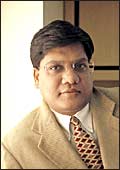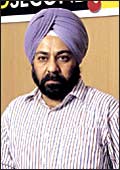 |
| Go4i's Gupta: An idea that
never took off |
Go4i.com
It was a horizontal portal promoted
by one of india's largest media organisations, The Hindustan Times
Ltd (Chase Capital was the other promoter). It was headed by Piyush
Gupta, a high-profile former Citibanker, reputed to have been
among the top 40 managers of the bank. Its advertising was reasonably
good and loud enough to be seen. And it had enough channels to
try and make a true horizontal play. An early-2001 IPO was being
talked about. Unfortunately, the company's advertising-driven
business model never really took off and in early 2001 (just around
the time it should have gone for an IPO), Hindustan Times decided
to cut its losses and bring the shutters down on Go4i.
-Sahad P.V.
Caltiger.com
In hindsight, Caltiger probably
received as much press as it did because of its contrarian play.
It was a Kolkata-based new economy venture. And, it was the country's
first and last free internet service provider. That's right, users
did not have to pay money for the company's dial-up service. The
company hoped to make money by making them watch ads. The ISP
was even thinking of streaming movie trailers to make money. The
business model didn't fly; the company hoped to make a comeback
with internet telephony, but that didn't work either.
-Sahad P.V.
Ideasnyou.com
This was a B2C venture promoted
by former Cadbury Schweppes CEO Ashok Jain, along with investment
banker Ashok Wadhwa, marketing consultant Rama Bijapurkar and
some 30-35 pros from sectors such as fast moving consumer goods
and banking. The company had four channels: Goodhealthnyou (a
health products site), Familynyou (a peer-to-peer site), Cricketnyou
and Customerpowernyou (a community of customers). Jain still heads
Goodhealthnyou, which has metamorphosed into a "full-fledged
healthcare communications firm" in his own words. What went
wrong? "It was just the way the industry went," says
Jain. "Asking this question now is as inane as wondering
why the Sensex is touching 8,000."
-Priya Srinivasan
Hometrade.com
 |
 |
 |
| Losing out: (Top to bottom)
Hometrade's Agrawal, Firstandsecond's MD G.B.s. bindra and
PurpleYogi's Mathur |
Well, this dotcom and its CEO made
the cover of this magazine well after the dotcom bust, courtesy
a scam involving corrupt politicians, gullible co-operative banks
and provident fund managers, and government securities. CEO Sanjay
Agrawal was arrested and everyone, including this magazine, pointed
out how Home Trade had burned some Rs 65 crore on an advertising
campaign featuring Hrithik Roshan (who later claimed he had not
been paid the entire amount promised to him), Sachin Tendulkar
and Shah Rukh Khan that did not really say what the product was
(an online brokerage, if you must know). Not many mainstream consumer
brands can afford to feature all three in a campaign. Then, those
were the days.
-Sahad P.V.
Broadcastindia.com
It was meant to be a media-rich
news channel with streaming audio and video. Founded by Sukaran
Singh, son of TV personality Nalini Singh, with VC funding from
Infinity, the site was probably ahead of its time. Now, when everybody
is talking about triple play and delivering rich media through
broadband, broadcastindia.com seems a prescient idea.
-Sahad P.V.
Firstandsecond.com
It set out to become India's Amazon,
tried a Barnes & noble, offline-online experiment for some
time, and continues to exist (yes, unlike some of the other sites
on this listing it lives and you can still buy books and music
on it). Yet, discounts seem a thing of the past (the fact that
you pay less has always been one of Amazon's unique selling proposition)
and the promise of what could have been remains just that, a promise.
-Sahad P.V.
PurpleYogi.com
Well, this wasn't strictly an Indian
firm, but it was founded by Valley-Indians; Junglee's Rakesh Mathur
was its CEO; and much of its technology work was being done out
of Bangalore. With $33 million (Rs 141.9 crore then) in funding
from companies such as Softbank and Infosys, PurpleYogi promised
to personalise the internet experience for users, helping them
easily access things that piqued their interest. Think of it as
a smart search aided by software downloaded by users on to their
machines. The company has since become Stratify and produces search
and mining software targeting the legal industry, but the sexiness
of being a purple yogi is long gone.
-Kushan Mitra
 |
 |
 |
| Dream that failed: (Top
to bottom) Arzoo's Bhatia, India's Singh and Indya's Kar |
Arzoo.com
In 1998, Microsoft bought out hotmail
for $400 million and hotmail co-promoter Sabeer Bhatia became
a poster boy of the internet and, back home in India, an icon
worth emulating. Arzoo was the young Bhatia's next venture. It
was born in March 1999, based in Fremont, California, with the
back-end in Bangalore (his home-town) and everyone was of the
opinion that it would revolutionise the world of e-commerce. Forbes
said it could become the mall of America yet be as easy to visit
as the neighbourhood shop. However, no one really bought anything
on Arzoo, Amazon was already there, and by June 2001 it was all
over. Arzoo shut shop leaving Bhatia with a hole in his pocket
and a dent in his reputation he is still trying to repair.
-Kushan Mitra
Skumars.com
This site too lives, but the project
that sought to invest $200 million to connect 30,000 kiosks across
India to an e-commerce web through VSAT terminals is a long-forgotten
dream. The company got into some trouble for taking too long to
repay the Rs 1,00,000 advance each of the 30,000 franchisee partners
had paid up and the venture ended up damaging the old economy
textile company's image.
-Kushan Mitra
India.com
Today, visitors to india.com will
find a free e-mail service that allows users to have a XXXXXX@india.com
address. That's a far cry from a company that set off in 2000
to be "definitive internet company for people and businesses
that have a link to the Indian community", according to a
publicity release. Around the same time CEO Digvijay Singh said
that his website would "as an early mover in the region,
steer the country's inherent resources to help it realise its
full potential". All very well; only, the company, then worth
$130 million, claimed to be in the vague business of "distributing
information technology products". By early 2002, the portal
was gone; the e-mail service remains.
-Kushan Mitra
Jaldi.com
Jaldi touted itself as an online
superstore, one where customers could buy a host of appliances
and durables at prices no bricks and mortar shop could match.
The premise behind this was demand aggregation: that Jaldi would
attract enough users to then drive a hard bargain with manufacturers.
However, customers didn't bite and by 2002, Jaldi was dead and
gone.
-Kushan Mitra
Indya.com
Founded by serial entrepreneur
Pradip Kar, with investments from the likes of Rupert Murdoch,
Rajat Gupta, Ram Shriram, Sanjay Parthasarthy and Yogen Dalal,
Indya was an ambitious horizontal play in the Indian internet
space. The company hired the best (or most expensive) talent available,
embarked on an advertising blitzkrieg, and launched its offering
amidst much fanfare. Unfortunately, the site itself proved a big
letdown (it was no Salon; let's leave it at that), and Indya never
achieved anything close to its anticipated volume of advertising.
By 2001, it was evident the Indya story was over. And in 2002,
in an effort targeted more at saving face than picking up the
pieces, Murdoch acquired all of Indya. It still remains Star Television's
online arm.
-Venkatesha Babu
|










